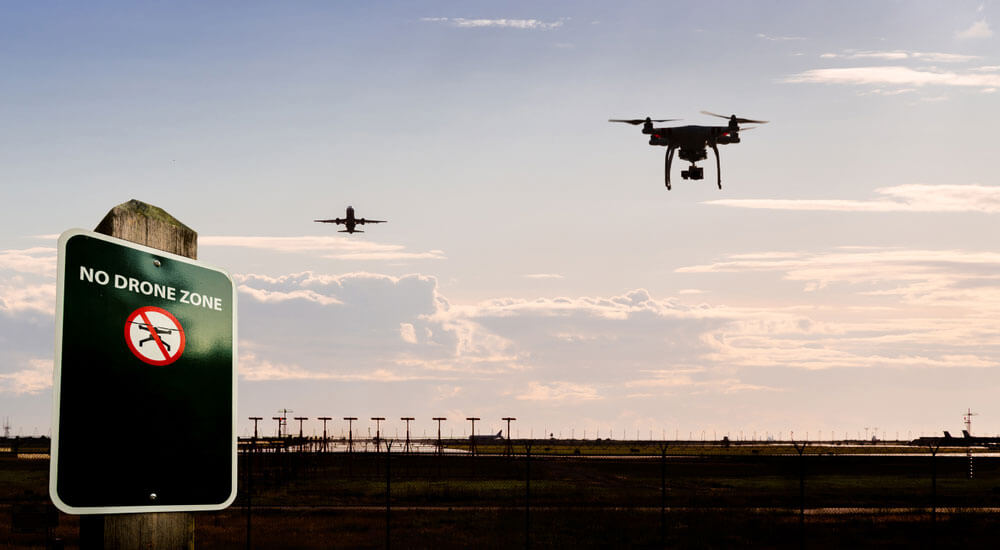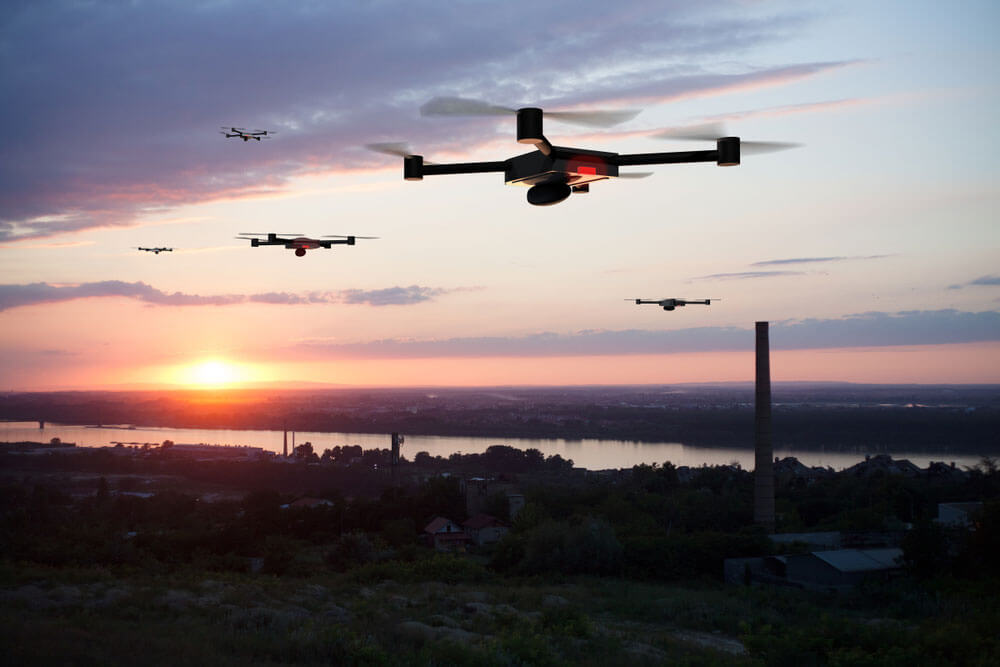Since before Thanksgiving, dozens of unidentified flying objects have been spotted in the skies over New Jersey and no one knows what they are. Are they drones? UFOs? Swamp gas reflecting from a weather balloon trapped in a thermal pocket and reflecting the light from Venus? The truth is, nobody seems to know for sure. State and local authorities, the Department of Defense, the Department of Homeland Security and even the FBI have been left scratching their heads. This isn’t how it’s supposed to work at all.
You might think that with a federal budget of six trillion dollars, we’d have a better handle on identifying mysterious objects flying over our most densely populated state. How was it supposed to work?
The Promise of Remote ID
Why don’t we know if aliens are invading New Jersey or if the state has a bunch of legitimate, enthusiastic nighttime drone enthusiasts? In theory, identifying drones should be a straightforward process.
The Federal Aviation Administration (FAA) mandated that drones must have “remote ID” – a system that broadcasts the drone’s location, altitude, ID number and information about its remote pilot via Bluetooth and Wi-Fi. Law enforcement should be able to point their cell phones at a suspicious drone and get all the information they need. That apparently is not happening.
When Theory Meets Reality: The Remote ID Fail
The FAA chose to implement remote ID using a low-power Bluetooth/Wi-Fi signal. In an ideal world, law enforcement could detect these signals from about a mile away. But if you’ve ever had your Bluetooth headphones disconnect when you walk into the next room or struggled to get Wi-Fi in your backyard, you can probably guess how well this works in practice.
The Road Not Taken
The FAA had several alternatives to using congested Wi-Fi/bandwidth at low power:
- Network Remote ID: Many drone operators suggested a “networked” remote ID using LTE/5G. This would have made drones visible on a nationwide network when near cell towers. However, the drone manufacturing industry, led by the Chinese company DJI, didn’t want networked remote ID because it would affect drone sales if buyers had to register an LTE chip at purchase.
- ADS-B: Some advocated for using low-power ADS-B, the same system used by manned aircraft. But the FAA Air Traffic, citing a desktop analysis of drones using ADS-B, feared drones would saturate the ADS-B frequencies when thousands of drones started broadcasting.
- Dedicated Frequency: Others (myself included) proposed a separate aviation-protected frequency specifically for drones. This failed because the FAA didn’t want to ask the Federal Communications Commission for a dedicated frequency.
Hence, low-power Bluetooth/Wi-Fi remote ID, the easiest solution, won the day. It was the easiest option, but arguably the least effective.
The Ripple Effects of Remote ID Limitations
The choice of low-power Bluetooth/Wi-Fi for remote ID has had far-reaching consequences:
- Can’t Use Cell Towers: There is no established antenna network because remote ID is a broadcast, not networked. So using the 142,000 existing cell phone towers to enable drone remote ID from any cell phone isn’t an option.
- Need for Massive Infrastructure: Building the type of nationwide remote ID broadcast network to make it effective would be a massive undertaking due to the low-power signal (six times less power than a cell phone).
- Police Can’t Identify Remote ID: Because remote ID uses the congested Bluetooth/Wi-Fi spectrum, it is difficult for law enforcement using their cell phones to distinguish drones from the signals of wireless printers or Bluetooth headsets in the area.
The result? Those mysterious lights over New Jersey could be perfectly legal drones using remote ID that law enforcement simply can’t detect. Or they could be drones operating illegally without remote ID. We just don’t know.

The Sensor Situation: Where Are Our Defenses?
You might be wondering, “Surely we have sensors that can detect drones operating without remote ID?” And you’d be right – to an extent. The U.S. government does have access to various sensor technologies such as:
- Electro-optical and infrared sensors: detect rogue drones at short ranges in good weather, even at night.
- Ku band radar: works wonderfully at longer ranges in all weather, day or night.
- Radiofrequency sensors: detect drones if they use a data link at very long ranges despite the weather or darkness.
Where are these advanced sensor systems? Primarily deployed at military bases, nuclear facilities and along the southern border. The rest of the country, including most of New Jersey, lacks comprehensive drone detection coverage.
A Bureaucratic and Legal Mess
So why aren’t these sensor systems more widely deployed? The answer lies in a complex web of bureaucratic and legal constraints:
- Few With Authority. Only a few federal agencies can operate all three types of sensors, leaving out the 18,000+ state, local, and tribal law enforcement departments and the industries with a vital interest in defending the nation’s critical infrastructure. Federal lawyers have convinced themselves that state, local or tribal agencies and commercial entities cannot take active measures against drones (i.e., take them down or jam) for a variety of reasons ranging from prohibitions on shooting down aircraft (the feds equate drones with airliners) to those against wiretapping/computer hacking (the feds equate drone data links with both private phone calls and home computers).
- Not A Core Mission For The Few That Do. The Department of Homeland Security (DHS) and the FBI, which are charged with defending most of America, don’t view aviation defense as a core mission. In their defense, they are already underfunded for their primary responsibilities. But because these agencies see counter-UAS as a massive unfunded mission, the critical task of defending our nations from drones has devolved into a game of musical chairs with the FBI the last agency standing. This was not because the FBI views air defense as a core mission or because they have deep experience in air defense or a massive existing air defense infrastructure, but because their argument as to why they shouldn’t shoulder the nation’s counter-UAS defenses was weaker than the other agencies.
- Authorities Are Limited. The Department of Defense (DoD) and Department of Energy can only defend their own facilities – and even this is limited in certain respects (some of this is classified so we won’t discuss it here, for obvious reasons).
America absolutely does not counter-UAS authorities vested in the proper agencies yet.
The Unintended Consequences
This bureaucratic tangle has led to some absurd situations. For instance, the only facilities in New Jersey with drone defenses are the DoD’s Picatinny Arsenal and Naval Weapons Station Earle. The Ocean County Sheriff’s Office in New Jersey launched their own drone to investigate the mystery drones, but could only “observe and report” their findings to federal authorities. Meanwhile, critical infrastructure like oil refineries, pharmaceutical plants and port facilities in New Jersey could not even do that much.
Outside of these two DoD facilities, the rest of the state is defenseless. DHS generally avoids deploying drone defenses outside their few protected areas and leaves this mission to the FBI. The FBI accepts the mission but only has a handful of agents working it.
Why This Matters for Autonomous Systems and Homeland Security
The situation in New Jersey isn’t just a quirky news story – it highlights significant gaps in our ability to monitor and secure our airspace against potential drone threats. As autonomous systems become more prevalent, our inability to effectively track and identify them poses serious risks to homeland security.
Consider the implications. Terrorist organizations could use drones for surveillance or attacks without detection. Critical infrastructure remains vulnerable to drone-based threats. The lack of effective airspace awareness hampers the legitimate development and use of autonomous systems for beneficial purposes. Public trust in drone technology and autonomous systems will continue to erode if we can’t distinguish between legal and potentially threatening drone activity.
A Wake Up Call
The mysterious drone sightings over New Jersey should serve as a wake-up call. Our current approach to airspace awareness and drone detection isn’t working as it should. In the world of drones and autonomous systems, this isn’t how it’s supposed to work – and we have the power to change it.
What should we do to find and mitigate rogue drones? That is a matter for a different drone defense mindset, a different set of counter-drone authorities, and a different article next month…

